Pandas を使用した JIRA 分析
問題
Atlassian JIRA が最も人気のある問題追跡ツールおよびプロジェクト管理ソリューションの 1 つであることに異論はありません。好きでも嫌いでも構いませんが、もしあなたがソフトウェア エンジニアとしてどこかの会社に雇われたのであれば、高い確率で JIRA に出会うでしょう。
取り組んでいるプロジェクトが非常に活発である場合、さまざまなタイプの JIRA 問題が何千も存在する可能性があります。エンジニアのチームを率いている場合は、JIRA に保存されているデータに基づいてプロジェクトで何が起こっているかを理解するのに役立つ分析ツールに興味があるかもしれません。 JIRA には、サードパーティのプラグインだけでなく、いくつかのレポート機能が統合されています。しかし、それらのほとんどは非常に基本的なものです。たとえば、かなり柔軟な「予測」ツールを見つけるのは困難です。
プロジェクトが大規模になればなるほど、統合レポート ツールに対する満足度は低くなります。ある時点で、API を使用してデータを抽出、操作、視覚化することになります。過去 15 年間の JIRA の使用中に、このドメイン周辺でさまざまなプログラミング言語によるそのようなスクリプトやサービスを多数見てきました。
日常的なタスクの多くは 1 回限りのデータ分析を必要とするため、毎回サービスを作成するのは効果がありません。 JIRA をデータ ソースとして扱い、一般的なデータ分析ツール ベルトを使用できます。たとえば、Jupyter を使用し、プロジェクト内の最近のバグのリストを取得し、「機能」(分析に役立つ属性) のリストを準備し、pandas を利用して統計を計算し、scikit-learn を使用して傾向を予測しようとします。今回はその方法について解説していきたいと思います。
準備
JIRA API アクセス
ここでは、JIRA のクラウド版について説明します。ただし、セルフホスト型バージョンを使用している場合、主な概念はほぼ同じです。
まず、REST API 経由で JIRA にアクセスするための秘密キーを作成する必要があります。これを行うには、プロファイル管理 - https://id.atlassian.com/manage-profile/profile-and-visibility [セキュリティ] タブを選択すると、[API トークンの作成と管理] リンクが表示されます。
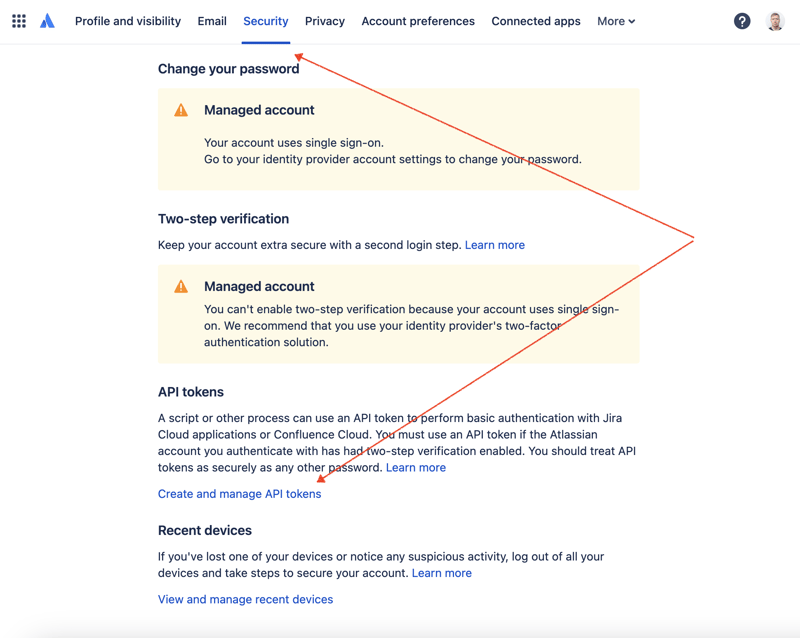
ここで新しい API トークンを作成し、安全に保存します。このトークンは後で使用します。
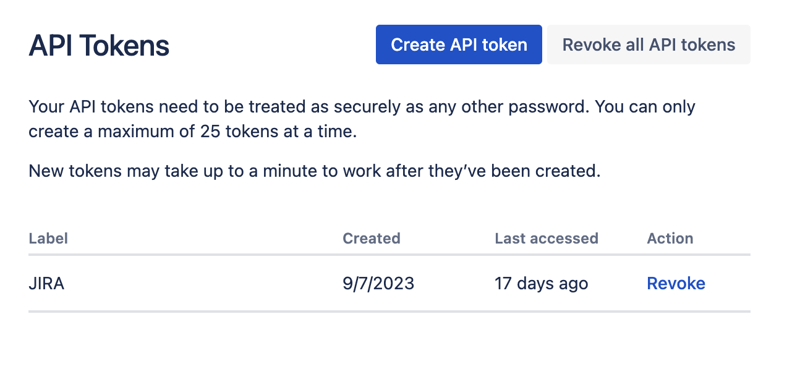
ジュピター ノートブック
データセットを操作する最も便利な方法の 1 つは、Jupyter を利用することです。このツールに慣れていない場合でも、心配する必要はありません。問題を解決するためにそれを使用する方法を説明します。ローカルでの実験には、JetBrains の DataSpell を使用するのが好きですが、オンラインで無料で利用できるサービスがあります。データサイエンティストの間で最もよく知られているサービスの 1 つは Kaggle です。ただし、ノートブックでは、外部接続を確立して API 経由で JIRA にアクセスすることはできません。もう 1 つの非常に人気のあるサービスは、Google の Colab です。これにより、リモート接続を確立し、追加の Python モジュールをインストールできます。
JIRA には非常に使いやすい REST API があります。 HTTP リクエストを実行する好みの方法を使用して API 呼び出しを行い、応答を手動で解析できます。ただし、その目的のために、優れた非常に人気のある jira モジュールを利用します。
動作中のツール
データ分析
すべてのパーツを組み合わせて解決策を考えてみましょう。
Google Colab インターフェースに移動し、新しいノートブックを作成します。ノートブックの作成後、以前に取得した JIRA 資格情報を「シークレット」として保存する必要があります。左側のツールバーの「キー」アイコンをクリックして適切なダイアログを開き、JIRA_USER と JIRA_PASSWORD という名前の 2 つの「シークレット」を追加します。画面の下部に、これらの「秘密」にアクセスする方法が表示されます:
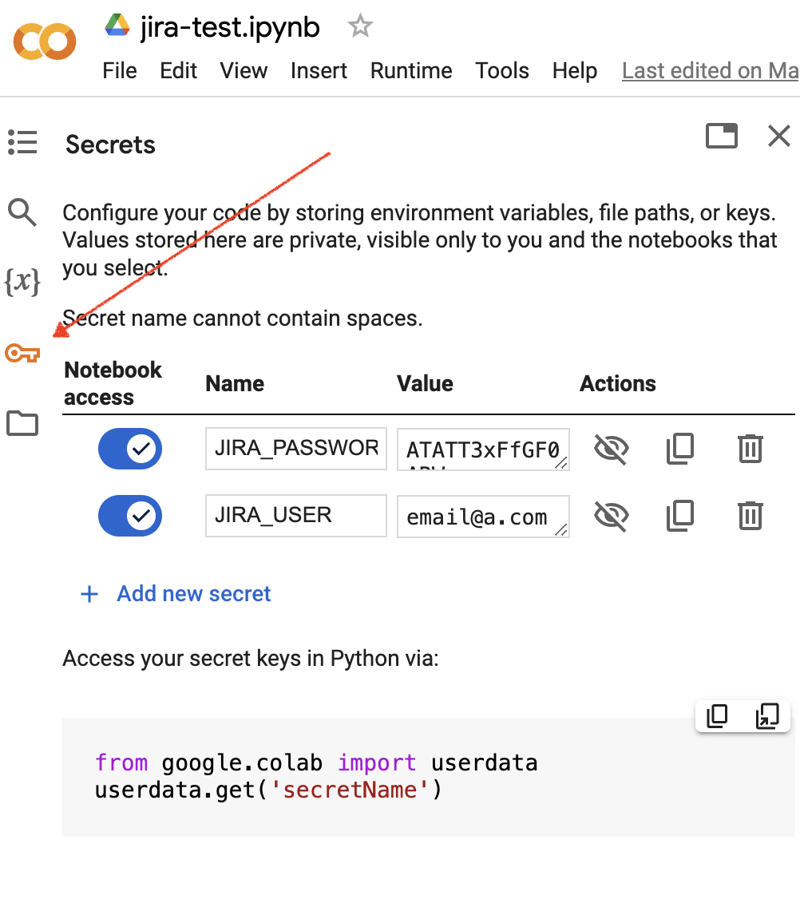
次に、JIRA 統合用に追加の Python モジュールをインストールします。これを行うには、ノートブックのセルのスコープ内でシェル コマンドを実行します。
!pip install jira
出力は次のようになります:
Collecting jira
Downloading jira-3.8.0-py3-none-any.whl (77 kB)
━━━━━━━━━━━━━━━━━━━━━━━━━━━━━━━━━━━━━━━━ 77.5/77.5 kB 1.3 MB/s eta 0:00:00
Requirement already satisfied: defusedxml in /usr/local/lib/python3.10/dist-packages (from jira) (0.7.1)
...
Installing collected packages: requests-toolbelt, jira
Successfully installed jira-3.8.0 requests-toolbelt-1.0.0
「シークレット」/認証情報を取得する必要があります:
from google.colab import userdata
JIRA_URL = 'https://******.atlassian.net'
JIRA_USER = userdata.get('JIRA_USER')
JIRA_PASSWORD = userdata.get('JIRA_PASSWORD')
そして、JIRA クラウドへの接続を検証します:
from jira import JIRA jira = JIRA(JIRA_URL, basic_auth=(JIRA_USER, JIRA_PASSWORD)) projects = jira.projects() projects
接続に問題がなく、認証情報が有効であれば、プロジェクトの空でないリストが表示されるはずです。
[<JIRA Project: key='PROJ1', name='Name here..', id='10234'>, <JIRA Project: key='PROJ2', name='Friendly name..', id='10020'>, <JIRA Project: key='PROJ3', name='One more project', id='10045'>, ...
これで、JIRA に接続してデータを取得できるようになります。次のステップは、pandas を使用して分析用のデータを取得することです。あるプロジェクトについて、過去数週間に解決された問題のリストを取得してみましょう:
JIRA_FILTER = 19762
issues = jira.search_issues(
f'filter={JIRA_FILTER}',
maxResults=False,
fields='summary,issuetype,assignee,reporter,aggregatetimespent',
)
データセットを pandas データ フレームに変換する必要があります。
import pandas as pd
df = pd.DataFrame([{
'key': issue.key,
'assignee': issue.fields.assignee and issue.fields.assignee.displayName or issue.fields.reporter.displayName,
'time': issue.fields.aggregatetimespent,
'summary': issue.fields.summary,
} for issue in issues])
df.set_index('key', inplace=True)
df
出力は次のようになります:
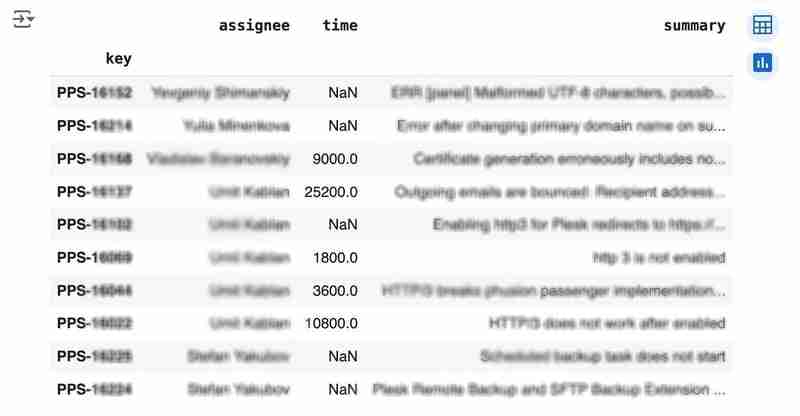
We would like to analyze how much time it usually takes to solve the issue. People are not ideal, so sometimes they forget to log the work. It brings a headache if you try to analyze such data using JIRA built-in tools. But it's not a problem for us to make some adjustments using pandas. For example, we can transform the "time" field from seconds into hours and replace the absent values with the median value (beware, dropna can be more suitable if there are a lot of gaps):
df['time'].fillna(df['time'].median(), inplace=True) df['time'] = df['time'] / 3600
We can easily visualize the distribution to find out anomalies:
df['time'].plot.bar(xlabel='', xticks=[])
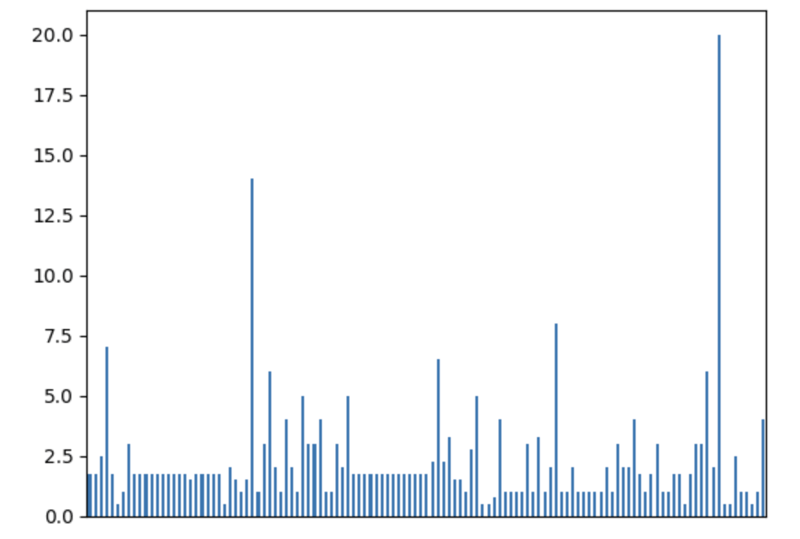
It is also interesting to see the distribution of solved problems by the assignee:
top_solvers = df.groupby('assignee').count()[['time']]
top_solvers.rename(columns={'time': 'tickets'}, inplace=True)
top_solvers.sort_values('tickets', ascending=False, inplace=True)
top_solvers.plot.barh().invert_yaxis()
It may look like the following:
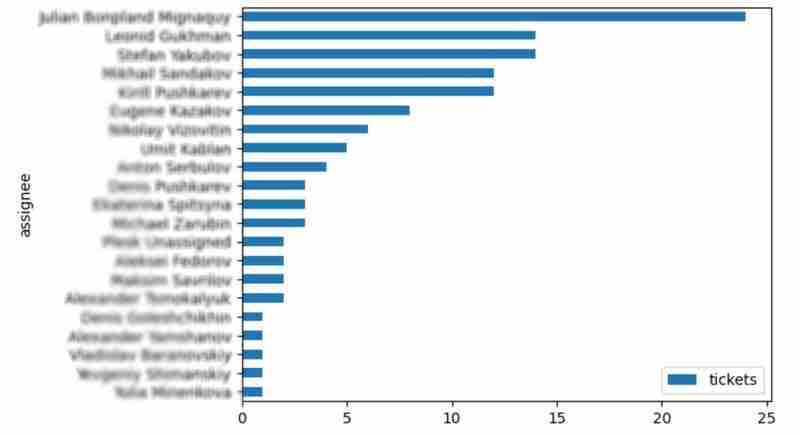
Predictions
Let's try to predict the amount of time required to finish all open issues. Of course, we can do it without machine learning by using simple approximation and the average time to resolve the issue. So the predicted amount of required time is the number of open issues multiplied by the average time to resolve one. For example, the median time to solve one issue is 2 hours, and we have 9 open issues, so the time required to solve them all is 18 hours (approximation). It's a good enough forecast, but we might know the speed of solving depends on the product, team, and other attributes of the issue. If we want to improve the prediction, we can utilize machine learning to solve this task.
The high-level approach looks the following:
- Obtain the dataset for “learning”
- Clean up the data
- Prepare the "features" aka "feature engineering"
- Train the model
- Use the model to predict some value of the target dataset
For the first step, we will use a dataset of tickets for the last 30 weeks. Some parts here are simplified for illustrative purposes. In real life, the amount of data for learning should be big enough to make a useful model (e.g., in our case, we need thousands of issues to be analyzed).
issues = jira.search_issues(
f'project = PPS AND status IN (Resolved) AND created >= -30w',
maxResults=False,
fields='summary,issuetype,customfield_10718,customfield_10674,aggregatetimespent',
)
closed_tickets = pd.DataFrame([{
'key': issue.key,
'team': issue.fields.customfield_10718,
'product': issue.fields.customfield_10674,
'time': issue.fields.aggregatetimespent,
} for issue in issues])
closed_tickets.set_index('key', inplace=True)
closed_tickets['time'].fillna(closed_tickets['time'].median(), inplace=True)
closed_tickets
In my case, it's something around 800 tickets and only two fields for "learning": "team" and "product."
The next step is to obtain our target dataset. Why do I do it so early? I want to clean up and do "feature engineering" in one shot for both datasets. Otherwise, the mismatch between the structures can cause problems.
issues = jira.search_issues(
f'project = PPS AND status IN (Open, Reopened)',
maxResults=False,
fields='summary,issuetype,customfield_10718,customfield_10674',
)
open_tickets = pd.DataFrame([{
'key': issue.key,
'team': issue.fields.customfield_10718,
'product': issue.fields.customfield_10674,
} for issue in issues])
open_tickets.set_index('key', inplace=True)
open_tickets
Please notice we have no "time" column here because we want to predict it. Let's nullify it and combine both datasets to prepare the "features."
open_tickets['time'] = 0 tickets = pd.concat([closed_tickets, open_tickets]) tickets
Columns "team" and "product" contain string values. One of the ways of dealing with that is to transform each value into separate fields with boolean flags.
products = pd.get_dummies(tickets['product'], prefix='product')
tickets = pd.concat([tickets, products], axis=1)
tickets.drop('product', axis=1, inplace=True)
teams = pd.get_dummies(tickets['team'], prefix='team')
tickets = pd.concat([tickets, teams], axis=1)
tickets.drop('team', axis=1, inplace=True)
tickets
The result may look like the following:
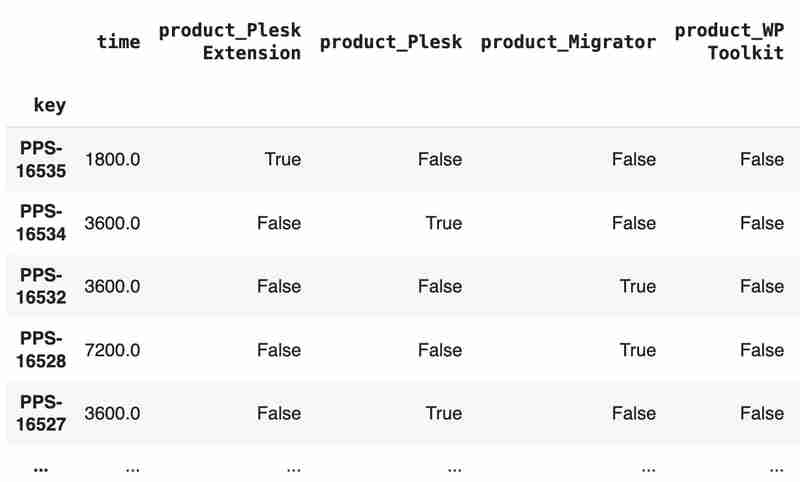
After the combined dataset preparation, we can split it back into two parts:
closed_tickets = tickets[:len(closed_tickets)] open_tickets = tickets[len(closed_tickets):][:]
Now it's time to train our model:
from sklearn.model_selection import train_test_split from sklearn.tree import DecisionTreeRegressor features = closed_tickets.drop(['time'], axis=1) labels = closed_tickets['time'] features_train, features_val, labels_train, labels_val = train_test_split(features, labels, test_size=0.2) model = DecisionTreeRegressor() model.fit(features_train, labels_train) model.score(features_val, labels_val)
And the final step is to use our model to make a prediction:
open_tickets['time'] = model.predict(open_tickets.drop('time', axis=1, errors='ignore'))
open_tickets['time'].sum() / 3600
The final output, in my case, is 25 hours, which is higher than our initial rough estimation. This was a basic example. However, by using ML tools, you can significantly expand your abilities to analyze JIRA data.
Conclusion
Sometimes, JIRA built-in tools and plugins are not sufficient for effective analysis. Moreover, many 3rd party plugins are rather expensive, costing thousands of dollars per year, and you will still struggle to make them work the way you want. However, you can easily utilize well-known data analysis tools by fetching necessary information via JIRA API and go beyond these limitations. I spent so many hours playing with various JIRA plugins in attempts to create good reports for projects, but they often missed some important parts. Building a tool or a full-featured service on top of JIRA API also often looks like overkill. That's why typical data analysis and ML tools like Jupiter, pandas, matplotlib, scikit-learn, and others may work better here.
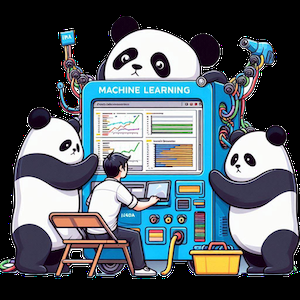
以上がPandas を使用した JIRA 分析の詳細内容です。詳細については、PHP 中国語 Web サイトの他の関連記事を参照してください。

ホットAIツール

Undress AI Tool
脱衣画像を無料で

Undresser.AI Undress
リアルなヌード写真を作成する AI 搭載アプリ

AI Clothes Remover
写真から衣服を削除するオンライン AI ツール。

Clothoff.io
AI衣類リムーバー

Video Face Swap
完全無料の AI 顔交換ツールを使用して、あらゆるビデオの顔を簡単に交換できます。

人気の記事

ホットツール

メモ帳++7.3.1
使いやすく無料のコードエディター

SublimeText3 中国語版
中国語版、とても使いやすい

ゼンドスタジオ 13.0.1
強力な PHP 統合開発環境

ドリームウィーバー CS6
ビジュアル Web 開発ツール

SublimeText3 Mac版
神レベルのコード編集ソフト(SublimeText3)
 Pythonを使用してExcelからWebフォームにデータ入力を自動化する方法は?
Aug 12, 2025 am 02:39 AM
Pythonを使用してExcelからWebフォームにデータ入力を自動化する方法は?
Aug 12, 2025 am 02:39 AM
Pythonを使用してExcelデータをWebフォームに入力する方法は次のとおりです。最初にPandasを使用してExcelデータを読み取り、次にSeleniumを使用してブラウザを制御してフォームを自動的に入力して送信します。特定の手順には、Pandas、OpenPyXL、Seleniumライブラリのインストール、対応するブラウザドライバーのダウンロード、Pandasを使用してdata.xlsxファイルの名前、電子メール、電話、その他のフィールドを読み取り、セレニウムを介してブラウザを起動してターゲットWebページを開き、フォーム要素を見つけ、レインごとにデータラインを提出します。ループ内のすべてのデータライン。
 メモリに収まらないPythonで大きなデータセットを処理する方法は?
Aug 14, 2025 pm 01:00 PM
メモリに収まらないPythonで大きなデータセットを処理する方法は?
Aug 14, 2025 pm 01:00 PM
Pythonのメモリを超える大きなデータセットを処理する場合、一度にRAMにロードすることはできません。代わりに、チャンク処理、ディスクストレージ、ストリーミングなどの戦略を採用する必要があります。 CSVファイルは、PandasのChunksizeパラメーターを介してチャンクで読み取ることができ、ブロックごとにブロックを処理できます。 Daskを使用して、Pandas構文と同様の並列化とタスクスケジューリングを実現して、大規模なメモリデータ操作をサポートできます。メモリの使用量を減らすために、テキストファイルをラインごとに読み取るためのジェネレーター関数を書き込みます。 Parquet Colornarストレージ形式をPyarrowと組み合わせて使用して、特定の列または行グループを効率的に読み取ります。 NumpyのMemmapを使用して大きな数値配列をメモリして、需要のあるデータフラグメントにアクセスするか、SQLiteやDuckDBなどの軽量データにデータを保存します。
 Pythonのクラスメソッドは何ですか
Aug 21, 2025 am 04:12 AM
Pythonのクラスメソッドは何ですか
Aug 21, 2025 am 04:12 AM
classMethodsinpythonareboundtotheclassandottoinstances、creatinginganobject.1.theyReadeDefinedTheSusingsingsisingsisthedtaklsasthefirstparameter、referringtotheclassiT self.2
 HDF5データセット名競合とグループ名:ソリューションとベストプラクティス
Aug 23, 2025 pm 01:15 PM
HDF5データセット名競合とグループ名:ソリューションとベストプラクティス
Aug 23, 2025 pm 01:15 PM
この記事では、H5PYライブラリを使用してHDF5ファイルを操作する際に、データセット名がグループ名と競合する問題の詳細なソリューションとベストプラクティスを提供します。この記事では、競合の原因を詳細に分析し、コード例を提供して、そのような問題を効果的に回避および解決してHDF5ファイルの適切な読み書きを確保する方法を示します。この記事を通じて、読者はHDF5ファイル構造をよりよく理解し、より堅牢なH5PYコードを書き込むことができます。
 Python Numpy配列の例
Aug 08, 2025 am 06:13 AM
Python Numpy配列の例
Aug 08, 2025 am 06:13 AM
numpyアレイの使用には、次のものが含まれます。1。配列の作成(リストからの作成、すべてのゼロ、すべてのゼロ、および範囲など)。 2。シェイプ操作(再シェープ、転置); 3.ベクトル化操作(追加、減算、乗算および分割、放送、数学機能); 4。インデックス作成とスライス(1次元および2次元操作)。 5。統計計算(最大、最小、平均、標準偏差、合計、軸操作)。これらの操作は効率的であり、ループは必要ありません。また、大規模な数値計算に適しています。最後に、もっと練習する必要があります。
 株式市場分析と予測にPythonを使用する方法は?
Aug 11, 2025 pm 06:56 PM
株式市場分析と予測にPythonを使用する方法は?
Aug 11, 2025 pm 06:56 PM
Pythonは、株式市場分析と予測に使用できます。答えはイエスです。 Yfinanceなどのライブラリを使用し、Pandasをデータクリーニングと機能エンジニアリングに使用し、MatplotlibまたはSeabornを視覚分析に組み合わせ、Arima、Random Forest、Xgboost、LSTMなどのモデルを使用して予測システムを構築し、バックテストによるパフォーマンスを評価します。最後に、アプリケーションはFlaskまたはFastapiで展開できますが、市場予測の不確実性、リスク、取引コストに過剰になることに注意を払う必要があります。成功は、データの品質、モデル設計、合理的な期待に依存します。
 文字列が番号の例であるかどうかをPythonチェックします
Aug 06, 2025 am 07:42 AM
文字列が番号の例であるかどうかをPythonチェックします
Aug 06, 2025 am 07:42 AM
ISDIGIT()は正の整数にのみ適用でき、小数、負の数、科学表記法をサポートしていません。 2。ISNUMERIN()は、画分などのより多くのユニコード数をサポートしますが、10進ポイントと負の兆候をサポートしていません。 3. ISDIGITと組み合わせた交換は、整数と小数を判断することができますが、科学的表記法をサポートしていません。 4. Try-Excecte Try Float変換は最も一般的な方法であり、整数、小数、負の数値、および科学表記法をサポートし、一般的なシナリオに推奨されます。 5.正規表現は、数字形式を正確に制御できますが、書き込みが複雑でエラーが発生しやすい。概要:最も実用的な方法は4番目の方法であり、これはシンプルで包括的にさまざまな数値形式をサポートし、完全な文で終わります。
 Python Asyncioキューの例
Aug 21, 2025 am 02:13 AM
Python Asyncioキューの例
Aug 21, 2025 am 02:13 AM
Asyncio.Queueは、非同期タスク間の安全な通信のためのキューツールです。 1.プロデューサーはawaitqueue.put(item)を介してデータを追加し、消費者はwaitqueue.get()を使用してデータを取得します。 2。処理する各アイテムについて、queue.task_done()を呼び出して、queue.join()がすべてのタスクを完了するのを待つ必要があります。 3。消費者に停止するように通知するために、最終信号としてなしを使用します。 4.複数の消費者の場合、複数のエンド信号を送信する必要があります。または、タスクをキャンセルする前にすべてのタスクを処理する必要があります。 5.キューは、マックスサイズの制限容量の設定をサポートし、操作を自動的に一時停止して取得し、イベントループをブロックしません。プログラムは最終的にCANCを通過します







